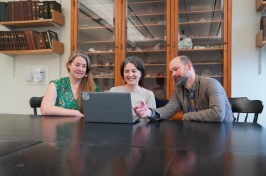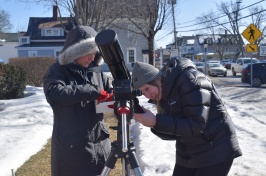Space Science Center
UNH Awarded $24 Million to Build Solar Wind Sensors for NOAA
The University of New Hampshire has been awarded $24.3 million by NASA, on behalf of the National Oceanic and Atmospheric Administration (NOAA), to build sensors for a high-priority alert system that will monitor the effects of space weather and the solar wind — caused by explosions on the sun —... Read More-
08/08/24
5 Ways Wildcats Are Staying Cool This Summer
Summer of ’24 has already broken heat records here in New England, but some in our UNH community are staying cool. Here are five ways our ’Cats are... -
07/25/24
UNH Makes Space Technology Available to Industry
UNH has launched its Space Technology Hub, a first-of-its-kind center in the region that provides testing facilities and expertise to the commercial... -
04/03/24
Student-led Project Examines Sun’s Corona During Total Eclipse
Six Ph.D. physics students from UNH were selected to participate in Citizen CATE 2024 project to collect data during the total solar eclipse. -
03/20/24
Predicting Solar Weather With Machine Learning
New grants from NASA and the National Science Foundation further UNH research into magnetospheric processes.
Recent Stories
-
08/31/22 - Lunar LaunchA UNH-built instrument will aid NASA's mission to send astronauts safely back to the moon. Read More
-
08/24/22 - Another Leap ForwardUNH researchers have received a $750,000 NASA grant to study gamma ray bursts. Read More
-
07/28/22 - Small WonderA new UNH study found that small satellites can be just as effective in performing important space science missions as their larger counterparts. Read More
-
06/08/22 - Searching for AnswersUNH will receive $906,055 from NSF ANSWERS to build on its existing strengths in space weather research and education. Read More
-
04/12/22 - Space StormsUNH researchers will receive $1.1 million to study space weather as part of the Center for Geospace Storms. Read More
-
04/04/22 - Federal FundingUNH is set to receive nearly $5.5 million in federal funding to support research, education, and energy resilience in the region. Read More
-
03/28/22 - Rocket ScienceUNH-built instruments aboard a rocket aimed at studying mysterious type of Northern Lights. Read More
-
03/07/22 - Back to OrbitA new satellite equipped with a UNH-built instrument will improve weather predictions on Earth and in space. Read More
-
02/10/22 - Solar WindfallUNH researchers have been selected to lead a NASA mission with a budget of $250 million to understand how the sun impacts the space environment around the Earth. Read More
-
02/02/22 - From the Sea to the StarsResearchers Atsushi Matsuoka and Fabian Kislet will explore carbon cycling in the ocean and X-rays in space with two National Science Foundation grants. Read More





































































